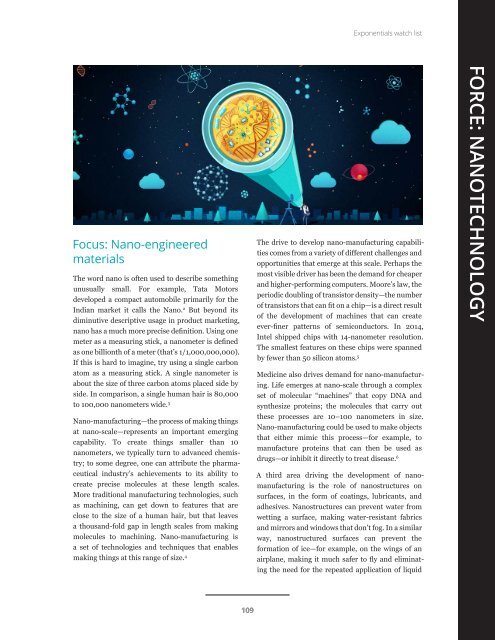Trending the trends Eight years of research
2kcf8xh
2kcf8xh
You also want an ePaper? Increase the reach of your titles
YUMPU automatically turns print PDFs into web optimized ePapers that Google loves.
Exponentials watch list<br />
Focus: Nano-engineered<br />
materials<br />
The word nano is <strong>of</strong>ten used to describe something<br />
unusually small. For example, Tata Motors<br />
developed a compact automobile primarily for <strong>the</strong><br />
Indian market it calls <strong>the</strong> Nano. 2 But beyond its<br />
diminutive descriptive usage in product marketing,<br />
nano has a much more precise definition. Using one<br />
meter as a measuring stick, a nanometer is defined<br />
as one billionth <strong>of</strong> a meter (that’s 1/1,000,000,000).<br />
If this is hard to imagine, try using a single carbon<br />
atom as a measuring stick. A single nanometer is<br />
about <strong>the</strong> size <strong>of</strong> three carbon atoms placed side by<br />
side. In comparison, a single human hair is 80,000<br />
to 100,000 nanometers wide. 3<br />
Nano-manufacturing—<strong>the</strong> process <strong>of</strong> making things<br />
at nano-scale—represents an important emerging<br />
capability. To create things smaller than 10<br />
nanometers, we typically turn to advanced chemistry;<br />
to some degree, one can attribute <strong>the</strong> pharmaceutical<br />
industry’s achievements to its ability to<br />
create precise molecules at <strong>the</strong>se length scales.<br />
More traditional manufacturing technologies, such<br />
as machining, can get down to features that are<br />
close to <strong>the</strong> size <strong>of</strong> a human hair, but that leaves<br />
a thousand-fold gap in length scales from making<br />
molecules to machining. Nano-manufacturing is<br />
a set <strong>of</strong> technologies and techniques that enables<br />
making things at this range <strong>of</strong> size. 4<br />
The drive to develop nano-manufacturing capabilities<br />
comes from a variety <strong>of</strong> different challenges and<br />
opportunities that emerge at this scale. Perhaps <strong>the</strong><br />
most visible driver has been <strong>the</strong> demand for cheaper<br />
and higher-performing computers. Moore’s law, <strong>the</strong><br />
periodic doubling <strong>of</strong> transistor density—<strong>the</strong> number<br />
<strong>of</strong> transistors that can fit on a chip—is a direct result<br />
<strong>of</strong> <strong>the</strong> development <strong>of</strong> machines that can create<br />
ever-finer patterns <strong>of</strong> semiconductors. In 2014,<br />
Intel shipped chips with 14-nanometer resolution.<br />
The smallest features on <strong>the</strong>se chips were spanned<br />
by fewer than 50 silicon atoms. 5<br />
Medicine also drives demand for nano-manufacturing.<br />
Life emerges at nano-scale through a complex<br />
set <strong>of</strong> molecular “machines” that copy DNA and<br />
syn<strong>the</strong>size proteins; <strong>the</strong> molecules that carry out<br />
<strong>the</strong>se processes are 10–100 nanometers in size.<br />
Nano-manufacturing could be used to make objects<br />
that ei<strong>the</strong>r mimic this process—for example, to<br />
manufacture proteins that can <strong>the</strong>n be used as<br />
drugs—or inhibit it directly to treat disease. 6<br />
A third area driving <strong>the</strong> development <strong>of</strong> nanomanufacturing<br />
is <strong>the</strong> role <strong>of</strong> nanostructures on<br />
surfaces, in <strong>the</strong> form <strong>of</strong> coatings, lubricants, and<br />
adhesives. Nanostructures can prevent water from<br />
wetting a surface, making water-resistant fabrics<br />
and mirrors and windows that don’t fog. In a similar<br />
way, nanostructured surfaces can prevent <strong>the</strong><br />
formation <strong>of</strong> ice—for example, on <strong>the</strong> wings <strong>of</strong> an<br />
airplane, making it much safer to fly and eliminating<br />
<strong>the</strong> need for <strong>the</strong> repeated application <strong>of</strong> liquid<br />
FORCE: NANOTECHNOLOGY<br />
109


